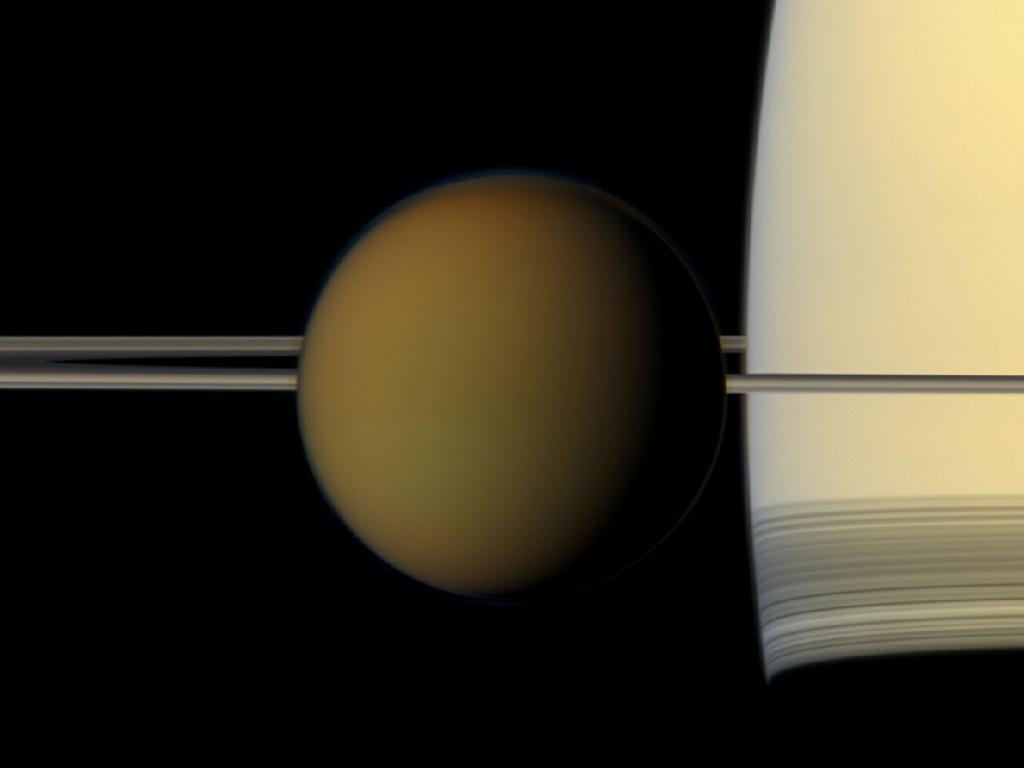
“On Titan, the molecules that have been raining down like manna from heaven for the last 4 billion years might still be there, largely unaltered, deep-frozen, awaiting the chemists from Earth.”
— Carl Sagan, “Pale Blue Dot: A Vision of the Human Future in Space” (1997)
You are standing on a shoreline peppered with small rounded rocks, watching the distant mountains on the horizon. Despite the dimly lit scenery and the thick smog that hangs in the air, you can detect clouds forming over those mountain tops that will soon develop into a raging rainstorm. Far from all this atmospheric fury, you enjoy the sight of the hundreds of small lakes around you which extend as far as the eye can see, unperturbed by the gentle breeze that blows through the landscape.
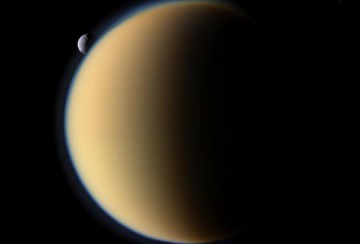
You could be forgiven for mistaking the above as a description of a terrestrial sight; yet it’s one that describes a typical day on Titan, Saturn’s largest moon. With a diameter of 5,150 km, Titan is a planet-sized moon, which could be rightfully described as one of the most Earth-like worlds in the entire Solar System—replete with a thick, opaque atmosphere, a hydrologic cycle similar to Earth’s, seasons, clouds, small mountains, long rivers, sand dunes, rocks, lakes, and seas. Yet at the same time it is as alien as it is Earth-like. Its atmosphere is oxygen-free and mostly composed of nitrogen and methane, its sand dunes are made of nitrogen-rich organic compounds, its rocks are made of water ice as hard as granite, and its hydrologic cycle is based on hydrocarbons like methane and ethane. The latter are found in a gaseous state on Earth—better known as natural gas—but on Titan they are liquids due to the moon’s frigid surface conditions. Indeed, with a surface temperature of -179 degrees Celsius, Titan could hardly be described as “home.” Even so, this fascinating and mysterious moon is viewed by most scientists as an early Earth analog before life arose that is rich in the chemical elements that constitute the basic building blocks of life, making it one of the best places in the Solar System, alongside Europa and Enceladus, to search for potential habitable environments.
A wet world
Even though it was discovered in 1655 by Dutch astronomer Christiaan Huygens, it wasn’t until the mid-20th century that Titan became an object of great fascination for astronomers, when Gerard Kuiper confirmed in 1944 that the distant moon was enshrouded by a thick methane-rich atmosphere. This discovery had great implications for astrobiology. If Titan was shrouded in an atmosphere rich in organic compounds, could it support seas and oceans of similar chemical composition on its surface as well? And if so, could the latter also be a habitat for life?
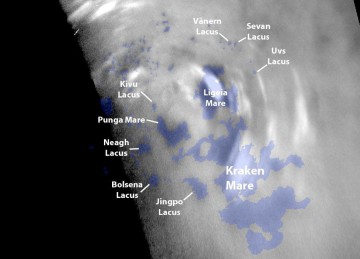
The ability to explore Titan up close and answer some of these questions came with the advent of the space age during the latter half of the 20th century. The first human-made object to ever pass by the Saturn system was Pioneer 11 in 1979; yet it wasn’t until the flybys of the twin Voyager 1 and 2 spacecraft in 1980 and 1981, respectively, that provided us with our first detailed views of the ringed planet and its assortage of moons. Nevertheless, when both Voyagers made their close approaches of Titan, they were greeted by a featureless moon—its surface was completely hidden from view by the presence of a thick haze layer in its upper atmosphere, which was opaque to all the wavelengths that the Voyagers’ instruments were sensitive to. Scientists had to wait for the launch of the joint NASA/ESA Cassini–Huygens mission in 1997 to finally get a chance at peering behind Titan’s veil. Equiped with a suite of 12 science instruments including a synthetic-aperture radar and a Visible and Infrared Mapping Spectrometer, the Cassini spacecraft was uniquely positioned to peer through Titan’s opaque atmosphere and provide us with our first detailed views of a fascinating alien world.
Following its arrival at Saturn in July 2004 after a seven-year journey throughout the Solar System, Cassini began to study the ringed planet and its 62 moons in unprecedented detail, illuminating many of their mysteries while returning images of ethereal cosmic beauty along the way. Possibly the single biggest highlight of the mission has been the deployment and parachuted descent of the Huygens probe, which was carried by Cassini, to the surface of Titan in January 2005, marking the historic, first-ever soft landing in the outer Solar System approximately one and a half billion kilometers from Earth. Despite a software programming error which resulted at the loss of one of Huygens’ two radio communication channels with the orbiting Cassini spacecraft, the probe was nevertheless able to send back detailed measurements of wind speed and direction during its 2.5-hour descent through Titan’s atmosphere, while providing us with our long-awaited first ever views of the moon’s previously hidden surface.
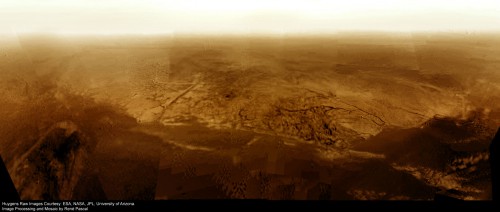
Prior to the Cassini mission, many scientists had speculated that Titan might be covered with large seas, or even a global ocean of liquid hydrocarbons. Yet, even though the images sent back by the Huygens probe were suggestive of a wet landscape which exhibited an extensive network of what looked like dark drainage channels and dried out shorelines that were cutting through a bright terrain, they revealed no large bodies of liquid on the surface. The landing site of the Huygens probe was also indicative of a wet environment, featuring dozens of small rounded pebbles not unlike those found on riverbeds on Earth. But while scientists concluded that the Huygens landing site was a dried out flood plain that had been carved by falling methane rain, they were surprised to see no traces of lakes or seas.
The Cassini spacecraft returned similar results during its first several flybys of Titan, while it probed the moon with each consecutive pass in search of these elusive alien waters. The mission’s science team got its first direct evidence of lakes on Titan during one of these flybys in June 2005. While passing over the moon’s south polar region, Cassini took one near-infrared image with its onboard Imaging Science Subsystem that revealed the presence of a 15,000-square-kilometer-wide dark feature very near the south pole, named Ontario Lacus, which had all the distinct morphological characteristics of a lake. “When we first saw it, we all said, ‘Holy cow! What is this? Its morphology is so distinct, it has very smooth boundaries, and it’s standing apart from everything else. It just looks like a lake’,” says Dr. Carolyn Porco, planetary scientist and leader of Cassini Imaging Team. The mystery was finally resolved by follow-up observations with Cassini’s Visible and Infrared Mapping Spectrometer during a subsequent flyby in December 2007, which showed that the enigmatic feature was indeed filled with liquid methane and ethane, making Ontario Lacus the first body of liquid ever to be identified on a celestial body other than the Earth.
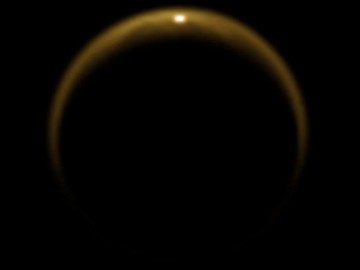
Yet as exciting as this finding was, Titan’s north pole proved to be an even more fascinating place. Radar observations by Cassini of the north polar regions in 2006 revealed that the latter were peppered with dozens much bigger lakes, the larger of which, named Kraken Mare, had a surface area of 400,000 km²—bigger than the Caspian Sea on Earth. Cassini’s radar imaging campaign of Titan’s north pole showed that apart from Ontario Lacus and a few other smaller lakes in the southern hemisphere, 97 percent of the moon’s seas and lakes were located in the north polar terrain, encompassing an area called the “lake district.” The approach of the vernal equinox on Titan in 2009, which signaled the coming of spring in the northern hemisphere, also gave the final proof that what scientists were observing was indeed those long-sought-for bodies of liquid on Titan’s surface. During a flyby over the moon’s northern hemisphere in July 2009, Cassini detected with its onboard Visible and Infrared Mapping Spectrometer a specular reflection of light coming from Kraken Mare, as the latter was bathed in its first rays of sunlight after 15 years of cold darkness, showcasing the mirror-like properties of the lake’s surface.
An extraterrestrial habitat?
Since Titan shares Saturn’s axial tilt of 27 degrees and the same 29.5-year orbit around the Sun, each season lasts for approximately 7.5 Earth years. When Cassini arrived at the Saturnian system in 2004, it was during the summer in the southern hemisphere while the northern hemisphere was covered in winter darkness. Since then, Cassini has observed the changing of seasons on Titan, with the summer now fast approaching in the north.
Scientists have determined that these seasonal changes drive a dynamic climate and atmospheric circulation pattern as well, with heavy cloud formations being observed by Cassini in various latitudes on Titan throughout its mission that are thought to be the evidence of present methane rain, which could also be creating underground propane aquifers as well. “It’s amazing to be watching such familiar activity as rainstorms and seasonal changes in weather patterns on a distant, icy satellite,” says Dr. Elizabeth Turtle, a planetary scientist at the University of Arizona and a Cassini imaging team Associate at the Johns Hopkins University Applied Physics Lab in Laurel, Md. “These observations are helping us to understand how Titan works as a system, as well as similar processes on our own planet.”
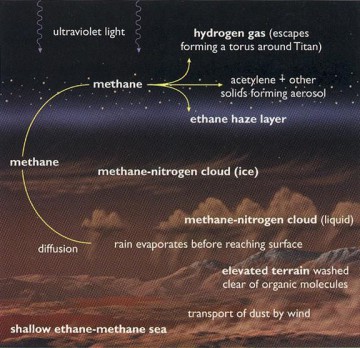
Since Titan’s surface is continuously replenished in organic compounds that fall like manna from the sky, could it also be a potential abode for life? “We know that there are conditions there that maintain liquid, there are energy sources, there’s organic material, there’s nutrients, there’s an environment that may be suitable for life,” says Chris McKay, a senior scientist at the Space Science and Astrobiology Division at NASA’s Ames Research Center in California. “But if there’s life there, it’s going to be completely different from anything we have one Earth.” The emergence of life on our planet was dependent on the presence of three key factors: liquid water, organic compounds, and an energy source. Titan shares many of the same characteristics with primordial Earth, except from the fact that at the frigid conditions that are present there the role of liquid water as a solvent of the chemical elements that are necessary for life is taken up by liquid methane. If life were ever to arise there, it would have a completely different biochemistry than that of terrestrial life, one that would be based on methane. Could such a thing be possible on Titan’s extremely low surface temperatures of -179 degrees Celsius?
A study which appeared in the June 2010 issue of the journal Icarus presented preliminary evidence which indicated a disparity in the global distribution of hydrogen on Titan’s upper atmosphere that, according to one interpretation, could be indicative of biological activity on the surface. Dr. Darrell Strobel, an Interdisciplinary Scientist for the Cassini mission at the Johns Hopkins University and author of the study, analyzed data taken by Cassini’s Composite Infrared Spectrometer and Ion and Neutral Mass Spectrometer instruments in order to measure the concentration of molecular hydrogen in Titan’s upper and lower atmosphere. Previous theoretical models had shown that hydrogen, which is the byproduct of the break up of compounds like methane and acetylene in Titan’s upper atmosphere by the Sun’s ultraviolet radiation, should be evenly distributed throughout the moon’s atmosphere. Yet Strobell’s analysis indicated that hydrogen wasn’t evenly distributed, but instead exhibited a disparity that led to a flow down to the surface at a rate of about 10,000 trillion trillion hydrogen molecules per second. “It’s as if you have a hose and you’re squirting hydrogen onto the ground, but it’s disappearing,” says Strobel. “I didn’t expect this result, because molecular hydrogen is extremely chemically inert in the atmosphere, very light and buoyant. It should ‘float’ to the top of the atmosphere and escape.” This result bode well with the conclusions of a previous study by Chris McKay and Heather Smith, a Postdoctoral Researcher at NASA’s Ames Researh Center in California, which proposed that if any hypothetical methane-based microbial life on Titan was consuming hydrogen to drive its metabolism, it could be detected among other things by anomalous depletion of hydrogen on the moon’s surface. “We suggested [in the study] hydrogen consumption because it’s the obvious gas for life to consume on Titan, similar to the way we consume oxygen on Earth,” says McKay. “If these signs do turn out to be a sign of life, it would be doubly exciting because it would represent a second form of life independent from water-based life on Earth.” Nevertheless, McKay is quick to point out that the results of Strobel’s study need further, independent confirmation. “The determination by Strobel that there is a flux of hydrogen into the surface of Titan is not the result of a direct observation,” writes McKay at the Cassini CICLOPS site. “Rather it is the result of a computer simulation designed to fit measurements of the hydrogen concentration in the lower and upper atmosphere in a self-consistent way. It is not presently clear from Strobel’s results how dependent his conclusion of a hydrogen flux into the surface is on the way the computer simulation is constructed, or on how accurately it simulates the Titan chemistry.”
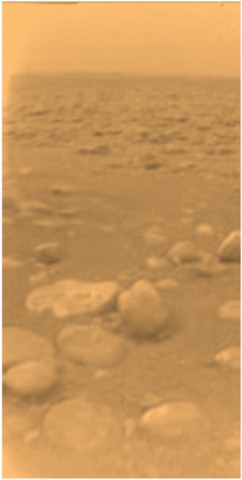
A second paper, which appeared in the October 2010 issue of the Journal of Geophysical Research by a team led by Dr. Roger Clark, a Cassini Mission scientist at the U.S. Geological Survey in Denver, Co, presented evidence for surface deposits of compounds like benzine, ethane, methane, and hydrogen cyanide on Titan, but not a trace of acetylene, which was thought to be plentiful on the moon’s surface. Again, the apparent absence of acetylene would be expected according to McKay and Smith if any methane-based microbes were present on Titan’s surface, metabolizing hydrogen and acetylene. Nevertheless, non-biological activity could also account for these findings as well, making it difficult for researchers to pinpoint their exact cause. “Scientific conservatism suggests that a biological explanation should be the last choice after all non-biological explanations are addressed,” says Mark Allen, an atmospheric chemist at NASA’s Jet Propulsion Laboratory in California. “We have a lot of work to do to rule out possible non-biological explanations. It is more likely that a chemical process, without biology, can explain these results – for example, reactions involving mineral catalysts.”
The ambiguity of these results doesn’t diminish Titan’s potential for life however. A series of laboratory experiments conducted during the past 50 years have showcased that chemical processes at conditions that simulated Titan’s environment could lead to the formation of more complex organic compounds than what was previously though possible. The most recent such experiment was conducted by a team led by Dr. Murthy Gudipati, Principal Scientist at NASA’s Jet Propulsion Laboratory. The researchers exposed molecules of dicyanoacetylene (an organic compound that is known to exist in Titan’s atmosphere) to laser light at wavelengths as long as 355 nanometers, simulating the levels of solar radiation that reaches Titan’s surface. The result of the experiment, which was presented at a study that was published at last year’s April 3 issue of the Nature Communications journal, was the formation of a brownish material of more complex organic material, better known as “tholins” (a term that was coined by the late Carl Sagan to describe the organic-rich chemistry that could result in conditions similar to Titan’s). Even though the term “organic” is somewhat misleading, indicating the presence of biologic activity, “tholins” could not be considered as living matter. Nevertheless, they are among the chemical precursors to life—some of the very building blocks of life’s chemistry. “Scientists previously thought that as we got closer to the surface of Titan, the moon’s atmospheric chemistry was basically inert and dull,” says Gudipati. “Our experiment shows that’s not true. The same kind of light that drives biological chemistry on Earth’s surface could also drive chemistry on Titan, even though Titan receives far less light from the Sun and is much colder. Titan is not a sleeping giant in the lower atmosphere, but at least half awake in its chemical activity.” “These results suggest that the volume of Titan’s atmosphere involved in the production of more complex organic chemicals is much larger than previously believed,” adds Dr. Edward Goolish, Deputy Director of of NASA’s Astrobiology Institute. “This new information makes Titan an even more interesting environment for astrobiological study.”
An underground ocean?
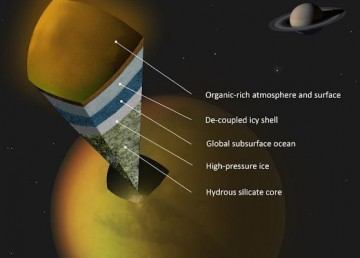
As exciting as this research on the potential habitable conditions of Titan’s surface has been, further findings from the Cassini spacecraft regarding the moon’s internal structure have proved to be equally intriguing. During a series of six flybys between 2006 and 2011 by the Cassini spacecraft, a research team led by Dr. Luciano Iess, a professor at the Sapienza University of Rome, Italy, mapped the fluctuations of Titan’s gravitational field in great detail in order to gain a better understanding of the internal structure of this fascinating world. The results of these observations showed that as Titan completed one orbit around Saturn every 16 days, it was squeezed and stretched by the massive planet’s gravity, which caused tides as high as 10 m. These were far higher for a body that was almost entirely composed of solid rock as was previously thought. The most plausible explanation, according to scientists for the observed tides, was the presence of a large underground water ocean below a hundred kilometer-thick ice shell that could be kept liquid by the internal heat generated from the decay of radioactive elements deep into Titan’s interior.
Considering that Titan’s surface is almost entirely composed of water ice, an underground liquid ocean opens up new possibilities for habitability on the distant moon. “Cassini’s detection of large tides on Titan leads to the almost inescapable conclusion that there is a hidden ocean at depth,” says Iess. “The search for water is an important goal in solar system exploration, and now we’ve spotted another place where it is abundant.” Could this underground water ocean be a possible abode for life, as is believed for the underground oceans of Jupiter’s moon Europa and Saturn’s moon Enceladus?
The answer to this question is beyond the scope of the Cassini spacecraft, which will continue to explore the Saturn system and slowly unravel its mysteries until the projected end of its mission in 2017. As of this date, no future missions to Saturn and its moons have been announced by NASA or any other space agency to follow-up on Cassini’s exciting and historic discoveries, leaving a disturbing void in our exploration of the majestic ringed planet and its many dozens of moons. Until we finally return to the Saturn system some indefinite time in the future, we will be left looking at Titan while silently wondering if any living things are patiently awaiting to be discovered, either on the surface or the probable underground waters of this most fascinating, distant world in the outer Solar System.
The last part of this article will focus on the moons of Uranus and Neptune.
Make sure to read Part 1, Part 2 and Part 3 as well
References:
1. “Ices and Oceans in the outer Solar System,” Dr. Robert Pappalardo,
public talk at the University of Nebraska–Lincoln, 14 April 2014.
2. “Finding Life Beyond Earth,” PBS, 2012
3. http://www.planetary.org/blogs/emily-lakdawalla/2005/titan_lake_0628.html
4. http://saturn.jpl.nasa.gov/news/newsreleases/newsrelease20110317/
5. http://www.ciclops.org/view.php?id=6744&js=1
6. http://www.ciclops.org/news/making_sense.php
7. http://www.nasa.gov/topics/solarsystem/features/titan20130403.html
8. http://science.nasa.gov/science-news/science-at-nasa/2012/28jun_titanocean/
Video Credit: SpaceRip/Thomas Lucas Productions
Want to keep up-to-date with all things space? Be sure to “Like” AmericaSpace on Facebook and follow us on Twitter: @AmericaSpace




Interesting, well-researched article, Leonidas! A fleet of landers to Titan and Europa along with “sample-return” capabilities would significantly enhance our knowledge of these two moons. THAT would be quite exciting.
Well done, Leonidas, as always! “Imperial Earth”‘s Titan is a dream away!